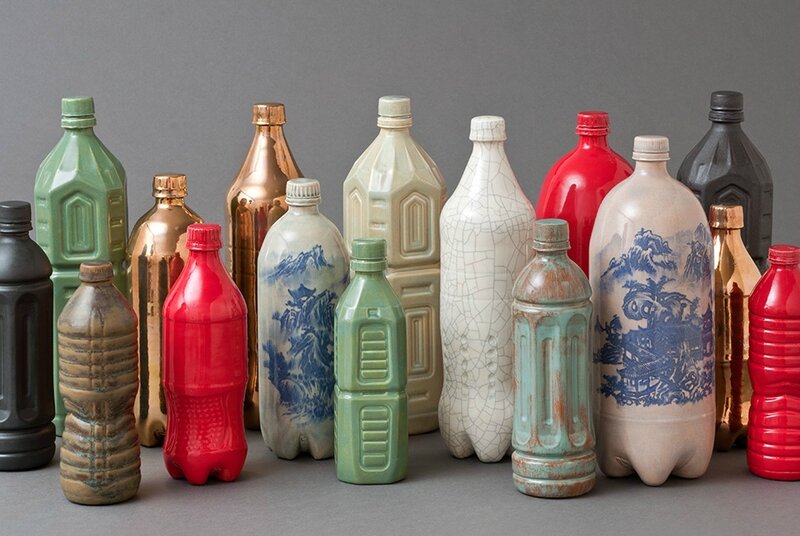Made in China: New ceramic works by Keiko Fukazawa on view at the Craft & Folk Art Museum
Keiko Fukazawa, Bearded Mao, porcelain, glaze, 2015. Collection of the artist. Photo: Susan Einstein
LOS ANGELES, CA.- The Craft & Folk Art Museum presents Made in China: New Ceramic Works by Keiko Fukazawa, the first solo museum exhibition of the Los Angeles-based ceramic artist. For the past three years, Fukazawa has visited Jingdezhen, China - the "porcelain capital" of the world - for artist residencies, where her observations of Chinese capitalism sparked a new body of concept-based work. Using porcelain busts of Chairman Mao Zedong, luxury brand logos, and timeless glazes, Made in China represents Fukazawa's playful and ironic examinations of the effects of globalization and consumerism in China. Made in China: New Ceramic Works by Keiko Fukazawa is on view from January 24 - May 8, 2016.
Fukazawa has been studying porcelain in Jingdezhen the last three years. The city has been a global center of ceramic production and innovation for almost 2,000 years, and its ceramics were one of the world's first globalized products. Jingdezhen serves as an appropriate anchor point for Fukazawa to explore the rapid spread of industrialization and capitalist strategies in China since the death of Chairman Mao Zedong in 1976. With 20% of the world's population and the second largest economy, China represents the worldwide challenges of globalization: loss of cultural practices, rampant consumerism, and severe environmental degradation.
The artist's fascination with China's state capitalism began in the late-2000s after reading an article on the exploitative child labor conditions in Chinese factories. Subsequently, she created ceramic Beanie Babies sculptures shaped into iconic scholars rocks to reflect on the rise of Chinese capitalism as a response to American consumer demand. During her time in Jingdezhen, Fukazawa has observed the lifestyle shifts in Chinese society as American-style consumer habits are being adopted.
Keiko Fukazawa, Red to Gold #2, earthenware, glaze, gold luster, decal, 2014. Collection of the artist. Photo: Susan Einstein
The works for Made in China were made collaboratively with local artisans to create several series' representing various processes and materials from Jingdezhen, including porcelain flower-making and traditional landscape painting. A series of porcelain busts representing mass-produced statues of Chairman Mao show him adorned yet almost drowning in delicate porcelain flowers - a reference to his Hundred Flowers Campaign, in which the public was encouraged to openly criticize the government but met with repression after doing so. A site-specific installation of Mao's outstretched arms will invite visitors to contribute paper flowers to the piece.
She goes on to decorate another series of multiples, based on domestic objects like spoons and tea flasks, with mass-produced decals of Chairman Mao in various stages of his life. These objects are glazed in a gradient ranging from red to gold, symbolizing China's journey through communism to its current iteration of state capitalism. A series of large porcelain boxes shows Chinese landscape paintings infiltrated by multinational corporate logos like Louis Vuitton and McDonald's.
Rejected parts from Jingdezhen's ceramic factories make their way into a series called Spout Monsters, in which mutant teapots have grown multiple limb-like spouts. The series Chinese Still Life shows groupings of cast plastic bottles glazed in a range of lustrous celadon and other finishes unique to Jingdezhen. Fukazawa often saw these bottles being discarded then reused as containers by glaze makers.
Keiko Fukazawa, Spout Monster No. 3, porcelain, glaze, 2015. Collection of the artist. Photo: Susan Einstein
"Keiko has been an active, long-time presence in the Los Angeles arts community, and we are very excited to present her work to a larger audience," says CAFAM Exhibitions Curator Holly Jerger. "The vast technical resources she encountered in Jingdezhen have allowed Keiko to make an important transition in her artistic practice and focus on conceptual issues she wanted to explore. This body of work is also a potent example of contemporary craft's relevance to world events, both historically and today."
Born and raised in Japan, Fukazawa currently lives and works in Pasadena, California. She studied at Musashino Art University in Tokyo and Otis College of Art and Design in Los Angeles, where she also taught ceramics for four years. She is currently assistant professor and head of the ceramic department at Pasadena City College. Her work is in the permanent collections of the Los Angeles County Museum of Art (LACMA), Los Angeles, California; the National Museum of History, Taipei, Taiwan; and Racine Art Museum, Racine, Wisconsin. Fukazawa is the recipient of a 2016 COLA Individual Artist Fellowship from the Department of Cultural Affairs, City of Los Angeles.
Keiko Fukazawa, Chinese Still Life #1, earthenware, glaze, transfer, gold luster, 2013. Collection of the artist. Photo: Susan Einstein

/https%3A%2F%2Fprofilepics.canalblog.com%2Fprofilepics%2F1%2F0%2F100183.jpg)
/https%3A%2F%2Fstorage.canalblog.com%2F03%2F02%2F119589%2F96711876_o.jpg)
/https%3A%2F%2Fstorage.canalblog.com%2F11%2F31%2F119589%2F94773502_o.jpg)
/https%3A%2F%2Fstorage.canalblog.com%2F20%2F83%2F119589%2F94772815_o.jpg)
/https%3A%2F%2Fstorage.canalblog.com%2F26%2F72%2F119589%2F75604929_o.jpg)
/https%3A%2F%2Fstorage.canalblog.com%2F59%2F60%2F119589%2F26458628_o.jpg)







/http%3A%2F%2Fstorage.canalblog.com%2F64%2F13%2F119589%2F112551627_o.jpg)
/http%3A%2F%2Fstorage.canalblog.com%2F80%2F11%2F119589%2F112354539_o.jpg)
/http%3A%2F%2Fstorage.canalblog.com%2F78%2F04%2F119589%2F112172769_o.jpg)
/http%3A%2F%2Fstorage.canalblog.com%2F03%2F87%2F119589%2F111450554_o.jpg)